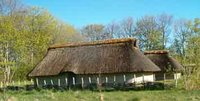Old barns

The Migration Period lasted for only about 150 years. This means that quite a number of the houses that were built toward the end of the Late Roman Period (AD 150-400) would still have been standing in the Early Vendel Period (AD 540-600). Many inhabited buildings probably burned down after a short time due to the poor fire safety of the day. But barns, where no fires were lit, were very likely quite long-lived. There are still 15th century or older wooden barns standing in the countryside of Sweden, more or less rebuilt, of course.
In the 6th century, the landscape was re-structured in much of agricultural southern Scandinavia. This may have been due to famine caused by the AD 536 atmospheric darkening event or to the Plague of Justinian (or both), and coincides with the shift from the Migration Period to the Vendel Period. It's the most dramatic change in material culture during the entire Iron Age in Scandinavia.
Anyway, in the mid-6th century drystone walls dividing the landscape were allowed to collapse and many settlements moved. At this time, there must have been a lot of 4th century building materials available. All you had to do was take an old barn down, load the posts on a wagon and use them at your new farm site. So if you’re into buildings typology, here’s a great argument to explain away those inconveniently early radiocarbon dates.
[More blog entries about Migration Period, archaeology, Sweden; folkvandringstiden, arkeologi.]



1 Comments:
There are quite a few wooden buildings preserved in northern parts of Russia dating back to 17th century.
Post a Comment
<< Home